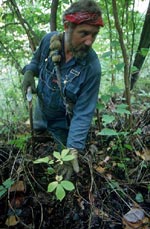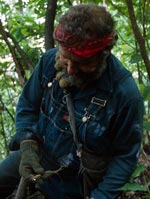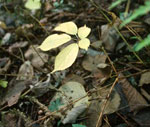Stalking the Wily Seng
Though in biological terms ginseng is properly flora, in the ginsengers' world it behaves like fauna. Ginseng is not merely "harvested," it is "hunted," and rare six-, seven-, and eight-prong specimens are coveted like twelve-point bucks. There is an agency assigned to ginseng unparalleled among the many plants valued on Coal River. "It hides away from man with seeming intelligence," wrote Arthur Harding in a 1908 manual for diggers and cultivators.14
"You never know where you're going to find ginseng," said Ernie Scarbrough, of Rock Creek.
Seng is a verb as well as a noun. "I senged in there, and senged in there, and senged in there," reported Cuba Wiley, of Peytona, "and I didn't find any." In stories about ginseng the plant appears unbidden, almost like a quarry sneaking up on its stalker. "I was standing there looking around," said David Bailey, of Stickney, "and there was a big four-prong brushing my britches legs before I looked down and saw it."
"Now a lot of times," said Joe Williams, "you'll walk up, be standing there, and look right down at your feet and it'll be there."
Ginseng's uniqueness is much vaunted. "It's the most beautiful plant in the woods," said Randy Halstead. "Especially when it changes its color and it's got the seed on it." In spring ginseng sends up a stem that branches into stalks, each terminating in a cluster of five toothed leaflets. The older the root, the more stalks, or "prongs," it sends up.15 A cluster of yellow-green flowers, scented like lilies of the valley, appears in spring and matures through the summer into the bright red "pod of berries" that ginseng diggers look for in fall.
In late September ginseng begins to turn an opalescent yellow, utterly distinctive to diggers. "That is a different color to any other yellow," said Dennis Dickens. "You can spot that."
On a warm day in September photographer Lyntha Eiler and I are clambering around on the near-perpendicular slopes of Tom's Hollow near Whitesville. Joe Williams, of Leevale, selected this site because it contained poplar and sassafras growing on the "wet side" of the mountain. "You don't find it where oaks are at," he says. He peers out through the columns of maples, hickories, sourwood, black gum, walnut, poplar, and sassafras, searching for brilliant red berries and the distinctive yellow of ginseng.
Slung over Williams's shoulder is a bag for carrying ginseng, and in his hand he carries a "seng hoe." Seng hoes are essentially double-bladed mattocks modified to serve as walking sticks. You cannot purchase one. On Coal River seng hoes are produced by recycling implements made for other purposes.
Taken as a collection, seng hoes register in concentrated form a pool of experiential knowledge attached to the commons. "They used to take old mine picks when they'd wear out and cut them off at the blacksmith shop," said Mae Bongalis, eighty, of Naoma. "They make a good one."
Herman Williams, of Clear Fork, has adapted a fire poker for use as a seng hoe. Ben Burnside's is made, like his father's, from a modified automobile spring. A popular model generally has an axe blade for cutting and a mattock blade for digging. Its long handle serves as a walking stick and a weapon to be wielded in self-defense against copperheads and rattlesnakes.
"It's real light," said Shorty Bongalis. "Something you can carry through the woods."
"It's light," said Randy Sprouse, "to beat the weeds."
Brandishing his seng hoe, Williams calls out in jest, "Here Mr. Four-Prong!" Ginseng is notoriously unpredictable. It does not send up a stalk every year.16 Added to this is the appetite for ginseng shared by deer, pheasants, groundhogs, squirrels, and other small birds and mammals which consume stalks and berries, unwittingly conserving the plant both by hiding the roots and serving as agents of dispersal. Thus theories of where to look for this seemingly peripatetic plant flourish.
"Everybody's got a different way of fishing," said Randy Halstead. "You know: 'My bait works.'"
Vernon Williams sengs in "the roughest, wildest, snakiest places" he can find. Denny Christian looks around "sugar trees" (Acer saccharum) and black walnut.
"If you look under the right tree," said Ernie Scarbrough, "you might find a stalk of seng. There's trees I go for yet, ginsenging…sugar maples and black gum, whenever you can find one. And the hickories. Squirrels is in the hickories, and they eat the ripe ginseng berries. So it makes a lot of ginseng around the hickories."
Ginseng orders the landscape around itself, providing a basis for identifying related flora. Look-alike plants like sarsaparilla and cohosh have been given nicknames like "fool's seng," "he-seng," and "seng pointer." "The reason why they call it 'seng pointer,'" said Randy Halstead, "it's got three branches, one goes this way, one this way, and one goes straight out this way, and the old people would say that one would be pointing towards the ginseng plant. Of course it probably is somewhere within a hundred miles out in front of it, but that's how that got started. They like the same kind of a place to grow."
Halstead said experienced dealers can tell which county a root came from because differences in soil conditions produce roots that are bulby like pearl onions, or elongated like carrots. "Now in this area we have dark, richer, loose soil, and the ginseng grows longer, like a carrot. But you get into some of the neighboring counties with clay soil, it's real bulby because the ginseng can't push down into the dirt."
Dealers can also tell at a glance whether a root is "wild" or "tame." "Wild" seng exhibits "stress rings" from pushing through wild soils. "Loosening the soil causes the roots to grow rapidly," explained Randy Halstead. "What makes the roots valuable is the ringiness, the rings that's on the ginseng."
Pausing for breath in Tom's Hollow, Joe Williams finds a four-prong, topped with a "pod of berries." Flailing away at its base he discovers to his chagrin that someone else has already taken the root, adhering to the local practice of replanting the stalk attached to the dog-legged rhizome pocked with stem scars. "That's called the 'curl,'" says Williams, carefully reinstating it. "I usually put maybe two joints of it back. It's a better way of keeping it going than the berries…I'll come back here some year and get another root off of that."
Other strategies for conserving ginseng include scattering seeds where ginseng is known to grow, snipping the tops off of "five-leaves" and "two-prongs" so that less scrupulous diggers won't find them until they are bigger in future years, and transplanting young plants to sites closer to home where they can be monitored.17
Many residents on Coal River propagate wild patches of ginseng in the woods surrounding their homes. "We didn't exactly cultivate it," said Dave Bailey. "See our back porch went up to here, and then up here was the woods. Me and my brother, we just got some of it and we set it, to see if it would come up next year, and when it did, it accumulated and accumulated, and whenever I got married and left, why the whole back of that hill was ginseng."
Left to its own devices, ginseng simply sheds the seeds for gravity to deliver downslope. Consequently, one mode of tracking ginseng is to look uphill from any "five-leaves" or immature plants for the big progenitor. "I've done that many a time," said Dave Bailey. "You go up the hill, you come to a little flat area and if there's any seng growing there you always look above it for a big one."

![]()
![]() Joe Williams ginsenging. Lyntha Scott Eiler. 1995/09/27. Library of Congress American Folklife Center.
Joe Williams ginsenging. Lyntha Scott Eiler. 1995/09/27. Library of Congress American Folklife Center.

![]()
![]() [Detail] Joe Williams digging a ginseng root. Lyntha Scott Eiler. 1995/09/27. Library of Congress American Folklife Center.
[Detail] Joe Williams digging a ginseng root. Lyntha Scott Eiler. 1995/09/27. Library of Congress American Folklife Center.

![]()
![]() [Detail] Ginseng plant leaves turn a distinctive pale yellow in the fall. Lyntha Scott Eiler. 1995/09/27. Library of Congress American Folklife Center.
[Detail] Ginseng plant leaves turn a distinctive pale yellow in the fall. Lyntha Scott Eiler. 1995/09/27. Library of Congress American Folklife Center.

![]()
![]() [Detail] Randy Sprouse's seng hoe. Lyntha Scott Eiler. 1996/06/26. Library of Congress American Folklife Center.
[Detail] Randy Sprouse's seng hoe. Lyntha Scott Eiler. 1996/06/26. Library of Congress American Folklife Center.

![]()
![]() [Detail] Ginseng drying in a window. Lyntha Scott Eiler. 1996/10/05. Library of Congress American Folklife Center.
[Detail] Ginseng drying in a window. Lyntha Scott Eiler. 1996/10/05. Library of Congress American Folklife Center.
